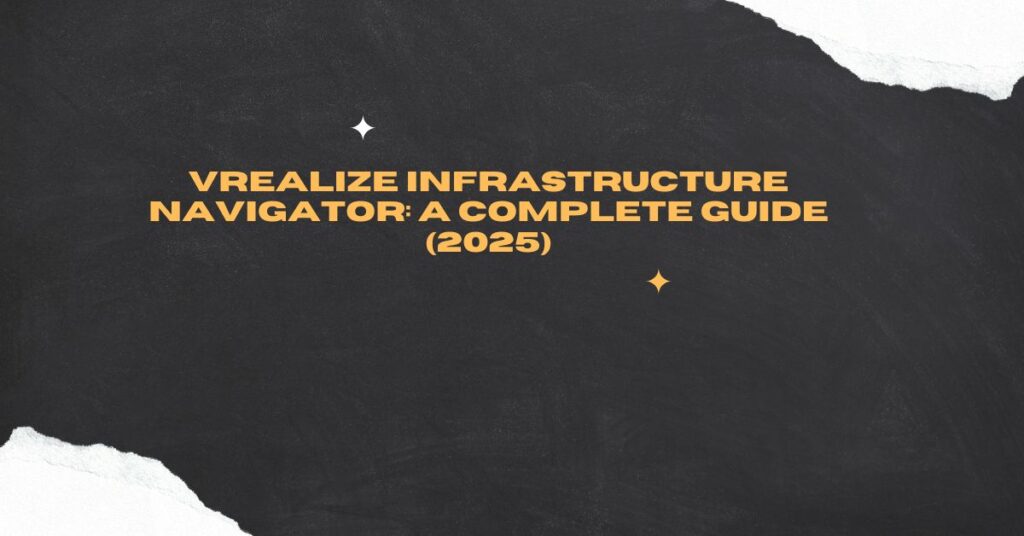What Is vRealize Infrastructure Navigator?
vRealize Infrastructure Navigator (VIN) was a VMware plug-in designed to enhance visibility across virtual environments by providing agentless application discovery and dependency mapping. It integrated with VMware vCenter and vRealize Operations Manager (vROps) to give IT admins a visual topology of how applications and virtual machines interact.
But that’s the past. Let’s understand its role, legacy, and what’s next.
Core Features of VIN
VIN wasn’t just a monitoring tool—it was a strategic insight engine for virtual environments. Here’s what it offered:
1. Automatic Application Discovery
VIN scanned virtual machines and used VMware Tools to identify common services like:
- Microsoft SQL Server
- Apache and Tomcat
- Microsoft Exchange
- Oracle DB
- WebLogic, and more.
This saved time compared to manual inventory or agent-based scanning.
2. Live Dependency Mapping
By analyzing inter-VM communication, VIN mapped:
- Application tiers (Web → App → DB)
- Service-to-service relationships
- Network dependencies
This was visualized through a topology view inside vCenter, helping teams avoid risky infrastructure changes.
3. Integration with vRealize Suite
VIN connected directly with:
- vCenter Server: For real-time data
- vRealize Operations Manager: For unified monitoring
- vRealize Automation: For deployment decisions
This tight integration made VIN ideal for change management, capacity planning, and troubleshooting.
🧓 End of an Era: VIN Deprecation and EOL
In 2017, VMware officially retired vRealize Infrastructure Navigator.
Key Milestones:
- End of Availability (EoA): August 2017
- End of Support (EoS): September 2017
- End of Technical Guidance: March 2018
Why was it discontinued?
- Dependency on Flash-based vSphere Web Client
- Limited support for newer OS and services
- Shift towards cloud-native architecture and containers
- Better alternatives emerged (see below 👇)
🔄 Modern Alternatives to VIN (2025)
Although VIN is no longer maintained, VMware and others offer modern service discovery tools built for today’s hybrid and multi-cloud ecosystems.
✅ 1. vRealize Operations Service Discovery Management Pack (SDMP)
The official successor to VIN, this pack integrates directly into vROps. It offers:
- Dynamic service discovery (via ports + process inspection)
- Real-time dependency visualization
- Application-aware alerting
- REST API access for automation
Compatible with:
- vROps 6.3+
- vSphere 6.5 and later
✅ 2. VMware Aria Operations for Applications (formerly Tanzu Observability)
Built for Kubernetes, containers, and VMs. Offers:
- End-to-end observability
- Real-time service maps
- Custom dashboards for microservices
✅ 3. Third-Party Tools
Consider:
- Dynatrace: Full-stack APM + AI-driven insights
- Datadog: Infrastructure + application dependency mapping
- SolarWinds: Network & system monitoring with AppStack view
- AppDynamics: Application discovery & performance monitoring
These options offer broader integrations (cloud, container, serverless) compared to VIN.
Also read: What is Protocolo Operacional Padrao.
Use Cases Where VIN Was a Game-Changer
Before deprecation, VIN added value in scenarios like:
Change Impact Analysis
Admins could visualize how changes to a VM might disrupt downstream services. This was critical during:
- Maintenance windows
- VM migrations
- Storage reconfigurations
Root Cause Analysis
VIN made it easier to trace:
“Why did this database slow down?” → check all connected front-end apps or services.
Disaster Recovery Planning
Dependency maps helped:
- Identify critical systems
- Determine failover priority
- Ensure all app tiers were protected
Limitations of VIN (Why It Had to Go)
Despite its strengths, VIN had serious drawbacks by modern standards:
| Limitation | Explanation |
|---|---|
| Outdated tech stack | Relied on Flash; incompatible with HTML5-based UIs |
| Limited protocol support | Missed apps not using standard ports |
| No cloud visibility | Couldn’t discover services in AWS, Azure, etc. |
| Static discovery | No support for containerized workloads or autoscaling systems |
What Should You Use in 2025?
For VMware-centric environments, the Service Discovery Management Pack (SDMP) is a drop-in replacement for VIN. If your infrastructure includes containers or multi-cloud, go with VMware Aria Operations or third-party APM tools like Datadog or Dynatrace.
Here’s a quick comparison table:
| Tool | VIN Replacement? | Cloud-Native Support | Dependency Mapping |
|---|---|---|---|
| SDMP | ✅ Yes | ❌ No | ✅ Yes |
| Aria Ops | ✅ Yes | ✅ Yes | ✅ Yes |
| Datadog | ✅ Partial | ✅ Yes | ✅ Yes |
| Dynatrace | ✅ Full | ✅ Yes | ✅ Yes |
Conclusion
Although vRealize Infrastructure Navigator is no longer active, it played a vital role in shaping how admins approached application-aware infrastructure. In today’s dynamic, cloud-driven world, tools must go beyond VM awareness—they need to understand microservices, APIs, and containers.
Whether you’re upgrading your legacy stack or deploying a fresh observability solution, VIN’s story teaches us the importance of visibility, automation, and adaptability.
FAQs
Is vRealize Infrastructure Navigator still supported?
No. It reached end of support in September 2017 and is no longer maintained by VMware.
What replaced vRealize Infrastructure Navigator?
VMware recommends the vRealize Operations Service Discovery Management Pack (SDMP) and Aria Operations for Applications as successors.
Can VIN run on vSphere 7 or 8?
Not reliably. VIN was built for vSphere 5.x and 6.x and doesn’t support HTML5-based vSphere clients.
What’s the best alternative for modern hybrid-cloud infrastructure?
Aria Operations, Datadog, or Dynatrace, depending on your use case and environment.
